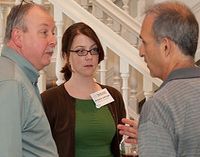July 2, 2009 -- The Library of Congress annual National Digital Information Infrastructure and Preservation Program meeting drew over 150 people from 20 states to share results from digital stewardship projects.
This was the largest number of attendees yet, and indicates success in building a fledgling national network of digital preservation partners.
Laura Campbell, Associate Librarian for Strategic Initiatives, opened the meeting with words of appreciation. "The energy and momentum you have created is very impressive," she said. "NDIIPP is recognized around the world as a model for national approaches to digital preservation, and a big reason for this is the enthusiasm and quality of the network members—all of you."
Martha Anderson, Director of NDIIPP Program Management, noted that the Library has renewed its outreach and communication efforts. She pointed to regular updates on the NDIIPP website. She then premiered a new Library online video presentation, "Bagit: Transferring Content for Digital Preservation."

Author and media theorist Clay Shirky. Credit: Barry Wheeler
Clay Shirky (external link) provided the meeting keynote. He discussed the social nature of digital preservation issues, including the distributed publishing model of the internet and what he described as "filter failure." Metadata is the key, but everyone is involved in assigning descriptors, not just librarians and archivists.
Shirky also said that, to succeed, digital preservation had to embrace an open social model. He drew comparisons in the shift from alchemy, which involved "failing in private," to modern chemistry, which is built on sharing results broadly.
Katherine Skinner and Gail MacMillan, from the MetaArchive Project, discussed two digital preservation surveys: one looking at electronic theses and dissertations, and the other considering cultural heritage institutions in general. Findings indicate cause for concern. Institutions stated that their preservation readiness is low, even though their desire to preserve digital materials is high.

Arizona State Library archivist Richard Pearce-Moses, Library of Congress digital archivist Michelle Gallinger and University of Maryland engineering professor Joseph JaJa. Credit: Barry Wheeler
Other talks provided details about projects to retrieve web content that is inaccessible through referenced hyperlinks; using cloud computing for digital preservation; and current U.S. copyright policies. Attendees also heard about developments regarding the Blue Ribbon Task Force on Sustainable Digital Preservation and Access (external link); the Unified Digital Format Registry (external link); and the Federal Digitization Standards Working Group.
The meeting featured 12 breakout sessions focusing on metadata, collaboration agreements, preserving dynamic content, web archiving and other topics.
Social media covered the meeting in some detail. The blog L'Archivista (external link) summarized all three days of the meeting, and there were a number of Twitter tweets (external link) sent during the meeting.
Slides and notes from all meeting sessions will be available later this month from the events section of the NDIIPP website.
